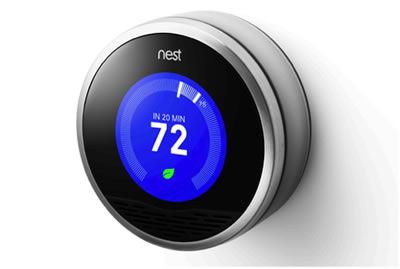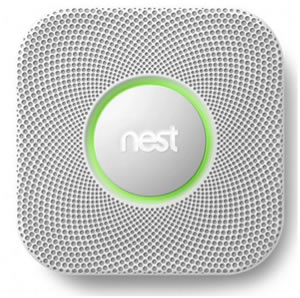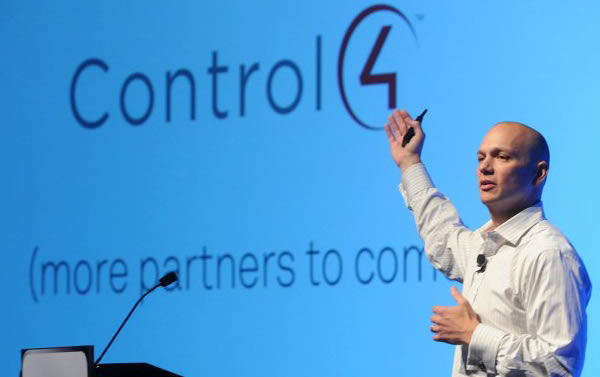 By Jesús Arias García, KNXin.
By Jesús Arias García, KNXin.
I got so excited about an interview with Tony Fadell by the UK edition of Wired magazine, that I put aside the article I had already written for this month, and offer you this instead!
For those unfamiliar with Fadell, let’s just say that he played a big part in Apple’s success. He worked for many years at the hardware department that delivered the iconic iPod and iPhone. Tired of not seeing his children enough, and after taking a sabbatical year, he decided to start his own company, Nest Labs. No doubt most of you who are involved with home automation and KNX have heard of the Nest thermostat.

Nest surprised the industry with this innovative, very well-designed product. The company continued in the Apple tradition of providing nice packaging, clear instructions, etc, and surprised the market further, with a second and unexpected product: a smoke alarm which, instead of producing terrible noises when an alarm occurs, talks to you!

Taking a Leaf from Tony’s Book
To give you a flavour of how I see this market developing and what its effect on the world of KNX could be, I have taken relevant excerpts from the interview and given my responses to them as follows:
TF: I went through every single device in the house, thinking, “How would you consume energy differently, how would you interface differently?” I was frustrated by so many products. The first one was the thermostat. It’s a product we ignore, that a lot of people hate, and get frustrated with.
JAC: It is easy to agree with this statement. I see many KNX thermostats that are incredibly difficult to manage, with extremely small displays and that lack intuition. Working based on a standard is important, but it does not ensure success. There is no need to follow the same patterns. Your KNX product has to follow certain technical criteria in order to be KNX compatible, but the design and user interface are down to your own creativity.
If we want KNX to continue penetrating the home automation market, especially in ‘virgin’ but important markets such as the USA, design and ease of use must be addressed, otherwise nobody will bother trying to introduce a technology that lags behind other products. Most of people do not care about the back end, but they do care about the front end.
TF: It gives you feedback to help you tune your habits. Why can’t the product adapt to you with a machine learning algorithm? Why can’t it tell when you’re not home and turn the heating down?
JAC: It is amazing how something as simple as setting your HVAC in standby when there is no presence detected is now being marketed as something ground-breaking. We have been delivering this capability for some time now, so what are we doing wrong? Aren’t we communicating this properly, or giving it the level of importance it deserves? It is also interesting to note how Fadell sells disruptive technology by mentioning an incredible algorithm that learns from your behaviour.
This great technology (i.e. a learning algorithm and presence detection) combined with the user-friendly interface are Fadell’s two key selling points, and they cannot be separated. They must be sold together.

TF: Now we can use those interfaces to plant extra displays on all these products around us to interact with.
JAC: It is only natural that, coming from the industry that Fadell comes from, he insists that his product must be able to interact with mobile devices and cutting-edge technology.
It is not a question of choosing between our technology or the incredibly-fast-developing technology from the mobile industry, but about opening our devices to other platforms. And this is should be embraced. After all, isn’t the smart move to join your enemy rather than fight them when you know that the battle is already lost?
TF: Internet of Things 1.0 is just trying to connect stuff. We’re trying to be Internet of Things 2.0 – where you dramatically change your relationship with the devices. The power of being on a network is when devices interact with other services.
JAC: In his speech at the Top Event at Light+Building 2014, Frank Kammerl talked about the new market situation and adapting to newcomers such as the Internet of Things.
If this were not enough, Fadell is now talking about Internet of Things 2.0! Building automation is one thing, and home automation is another. The end users of homes are people who are constantly in touch with all of these concepts and are used to these fast-developing technologies. They are amongst us. Indeed they expect anything related to technology to be at the same level as their smart devices. Anything less will not do.
TF: It’s all networked today. It’s called the power network. And we are talking about adding one more piece of the puzzle on that network: it’s called data.
JAC: ‘The Art of Creating Concepts’ is a technique that works very well over in the USA. Having the technology or the idea is not enough, it must have an appealing name, and it needs to pass the elevator pitch test (i.e. a few words and a few seconds to sell the idea).
In a very clever way, Fadell associates the electrical network of our homes with data, avoiding the outdated home automation concept. If you do not agree, send me an email.
Conclusion
I suggest you look at the whole article and think about what impact that will have on our market.
If we assume that everybody knows about the benefits of KNX and that the existing concepts are just fine, we will not get very far. But by keeping a critical eye on ourselves and being willing to adapt, whilst maintaining our core strengths of being standards-based and interoperable, I bet we can lead the market.
And if you wonder why I put so much store by what Fadell says, remember that Nest Labs was recently sold to Google for US$3.2 billion.
Jesús Arias García is a freelance Engineering Consultant for KNXin, a consultant engineering firm specialising in KNX technology and green buildings. His co-authored book ‘KNX for LEED‘ is available through the KNX Online Shop.
You are welcome to comment on this article. See below.











